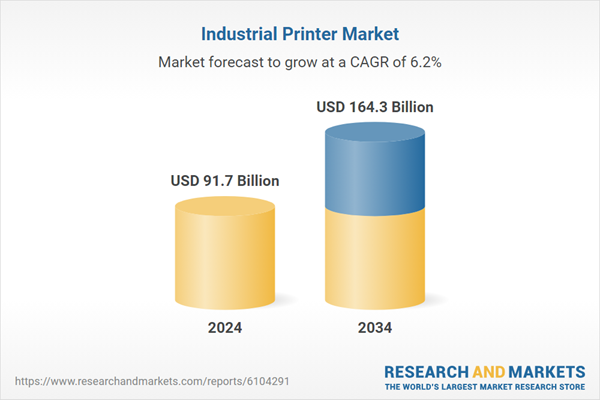The shift from analog to digital printing platforms has helped improve synchronization with ERP systems and supply chains, promoting operational efficiency. Meanwhile, growing emphasis on eco-conscious practices has increased interest in low-waste, energy-efficient printing solutions. As more industries embrace automation and real-time tracking, industrial printing is rapidly evolving to meet changing demands and production cycles.
An expanding range of industrial use cases is also contributing to market growth, including branding applications and precise circuit printing needs in electronics. Sectors such as textiles and electronics are increasingly using digital and inkjet printers for flexible, on-demand production. Packaging remains the top application area, fueled by increasing demand for smart, personalized packaging. Smaller businesses are adopting compact desktop printers due to affordability, while traditional analog printers still cater to large-scale production across established industries.
In 2024, digital printing generated USD 25.1 billion and is projected to reach USD 47.32 billion by 2034. The rapid growth of this segment is attributed to its efficiency, ability to deliver quick results, and elimination of setup needs such as printing plates. This makes it ideal for short-run, customized, and time-sensitive projects. Its adoption is strong in industries where precision and frequent design changes are essential. Features like vivid color output, high-quality imaging, and on-demand printing capabilities make digital printers a go-to for advanced packaging and labeling. Additionally, sustainable features such as energy-efficient operations and the use of non-toxic inks align well with corporate environmental goals.
The packaging sector dominated the industrial printer market in 2024, accounting for 42.9% of the overall share, and is projected to grow at a CAGR of 6.6% through 2034. Demand for high-performance printing in this segment is driven by the rapid growth of online retail and the push for branded and customized packaging. Industrial printers are essential in this space for their ability to cost-effectively produce detailed labels, graphics, and barcodes at scale.
This is particularly important as industries such as FMCG, healthcare, and food services increasingly adopt flexible packaging formats. As sustainability becomes a priority, there’s greater interest in recyclable materials and eco-friendly inks. The capacity of industrial printers to deliver high-speed, waste-free prints on demand is a key asset for meeting dynamic packaging needs.
North America Industrial Printer Market generated USD 25.15 billion in 2024. The region’s strong foundation in packaging, electronics, and pharmaceutical manufacturing continues to support the rise in demand for on-demand labeling and smart packaging solutions. As personalization trends gain momentum, businesses across North America are upgrading their printing capabilities to deliver precise, fast, and custom results. The region also benefits from the increasing need for barcode and shipping-related prints due to a thriving e-commerce sector.
Prominent players in the Global Industrial Printer Market include Ricoh Company Ltd., Domino Printing Sciences, Canon Inc., Mutoh Holdings Co., Ltd., HP Inc., Durst Phototechnik AG, Epson Corporation, Kornit Digital Ltd., Zebra Technologies Corporation, Seiko Holdings Corporation, Xaar plc, Brother Industries Ltd., Konica Minolta, Inc., Heidelberger Druckmaschinen AG, Xerox Holdings Corporation. Leading industrial printer manufacturers are focusing on strengthening their market position through R&D investments in digital technologies and sustainable materials. Many are rolling out energy-efficient printers with enhanced image resolution, as well as compact, cost-effective models tailored for SME.
Companies are also expanding portfolios by integrating software for real-time data monitoring and automated workflow, improving traceability and operational efficiency. Collaborations with industrial automation firms and supply chain solution providers help enhance their value propositions. Additionally, players are aligning with environmental goals by developing low-VOC inks and recyclable cartridges.
Comprehensive Market Analysis and Forecast
- Industry trends, key growth drivers, challenges, future opportunities, and regulatory landscape
- Competitive landscape with Porter’s Five Forces and PESTEL analysis
- Market size, segmentation, and regional forecasts
- In-depth company profiles, business strategies, financial insights, and SWOT analysis
This product will be delivered within 2-4 business days.
Table of Contents
COMPANIES MENTIONED
The companies featured in this industrial printer market report include:- Brother Industries Ltd.
- Canon Inc
- Domino Printing Sciences
- Durst Phototechnik AG
- Epson Corporation
- Heidelberger Druckmaschinen AG
- HP Inc
- Kornit Digital Ltd.
- Konica Minolta, Inc.
- Mutoh Holdings Co., Ltd.
- Ricoh Company Ltd.
- Seiko Holdings Corporation
- Xaar plc
- Xerox Holdings Corporation
- Zebra Technologies Corporation
Table Information
| Report Attribute | Details |
|---|---|
| No. of Pages | 190 |
| Published | June 2025 |
| Forecast Period | 2024 - 2034 |
| Estimated Market Value ( USD | $ 91.7 Billion |
| Forecasted Market Value ( USD | $ 164.3 Billion |
| Compound Annual Growth Rate | 6.2% |
| Regions Covered | Global |
| No. of Companies Mentioned | 16 |









